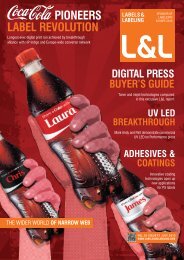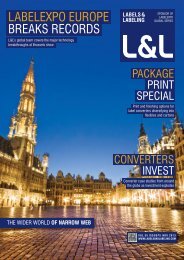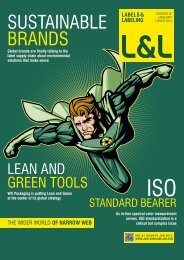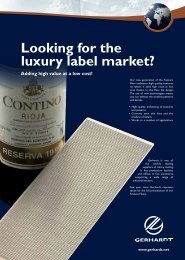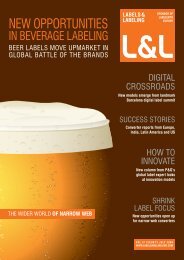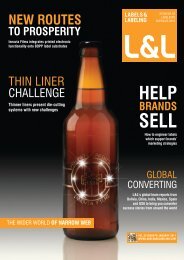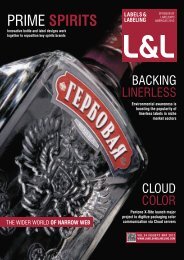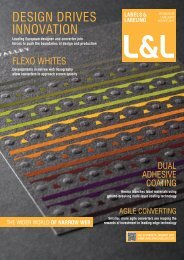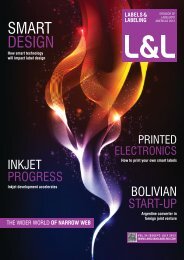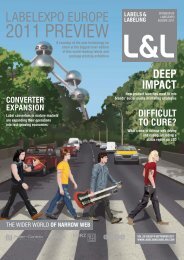THE DATA FRONT
Download as PDF - Labels & Labeling
Download as PDF - Labels & Labeling
- No tags were found...
Create successful ePaper yourself
Turn your PDF publications into a flip-book with our unique Google optimized e-Paper software.
Labels&Labeling |55<br />
Spartanics brings<br />
Finecut to Europe<br />
An open house hosted by Spartanics-Systec introduced the Finecut laser cutting system to Europe, and<br />
recent software developments will allow it to compete with rotary die cutting, as James Quirk reports<br />
Laser technology is nothing new, but a variety of issues have<br />
prevented it cementing itself as a widespread alternative to<br />
rotary die cutting in the finishing sector. Speed, issues with<br />
achieving right angled cuts, varied performance on different<br />
substrates, not to mention cost, have all conspired to keep the<br />
technology on the periphery of mainstream label production.<br />
But a recent open house organized<br />
by US-based Spartanics, held in<br />
Bielefeld, Germany at its partner<br />
Systec, a manufacturer of screen<br />
printing equipment and drying systems,<br />
showcased a laser cutting system which<br />
the company believes will not only set<br />
new standards for digital finishing, but<br />
also compete directly with rotary die<br />
cutting in the flexo market.<br />
This was the European debut of Spartanic’s Finecut laser<br />
cutting system, the first of three appearances in the region<br />
which will culminate at Labelexpo Europe, in Brussels, in<br />
September. The Finecut, which comes in roll- and sheet-fed<br />
versions, can achieve speeds of up to 100 m/min, a<br />
breakthrough which Mike Bacon, Spartanics’ VP of sales and<br />
marketing, says is only the beginning. ‘We could go faster<br />
with two laser sources, but it gets to the point where the cost<br />
is prohibitive. We believe we can get to 150 m/min, using only<br />
one laser, within the next year.’<br />
This increase in speed is just one of the elements that Bacon<br />
believes will allow the Finecut to compete with rotary die cutting<br />
in the flexo market. ‘A year ago, we couldn’t compete; but now,<br />
with these speeds, we can. With the trends towards shorter<br />
runs and multiple jobs, rotary tools need to be changed more<br />
"We could go faster with two<br />
laser sources, but it gets to<br />
the point where the cost is<br />
prohibitive. We believe we can<br />
get to 150 m/min, using only<br />
one laser, within the next year"<br />
regularly, which gives laser cutting an advantage.’<br />
Software advances, too, are crucial. ‘While laser technology<br />
has been around for a while, the software capabilities had<br />
not been catching up with the lasers,’ says Bacon. ‘We’ve<br />
made a concerted effort to develop the software – it’s all<br />
about what you tell the laser to do.’ The Finecut is controlled<br />
by sophisticated software integrated to<br />
provide constant monitoring feedback<br />
and control of all system operations,<br />
including registration, web control, laser<br />
power, laminating and slitting. A pictorial<br />
operator interface, specifically designed<br />
for digital laser cutting, allows swift<br />
modifying of the pattern to be cut. Job<br />
parameters can easily be entered, making<br />
quick work of adjusting to the variety of<br />
materials, material widths and thicknesses, and part sizes that<br />
are encountered. ‘We’re aware of how difficult it is nowadays to<br />
recruit good operators,’ says Bacon, ‘so we have focused on<br />
making the system as easy as possible to use.’<br />
The Finecut also includes a quick, accurate job quote<br />
tool, which identifies the maximum web speed and cut per<br />
part. Print registration is flexible, and senses anything that<br />
has contrast and shape. The laser operates across a variety<br />
of cutting fields depending on the system configuration.<br />
However, the 200mm x 200mm system is ideal for narrow web<br />
label production. ‘The configuration of the laser is triggered,<br />
and can be changed, by a barcode or registration mark or<br />
color, for example,’ says Bacon. ‘It takes 30 seconds from<br />
reading to configuring a new cutting pattern, so waste is<br />
minimal, just a handful of labels.’<br />
may 2009 | L&L



